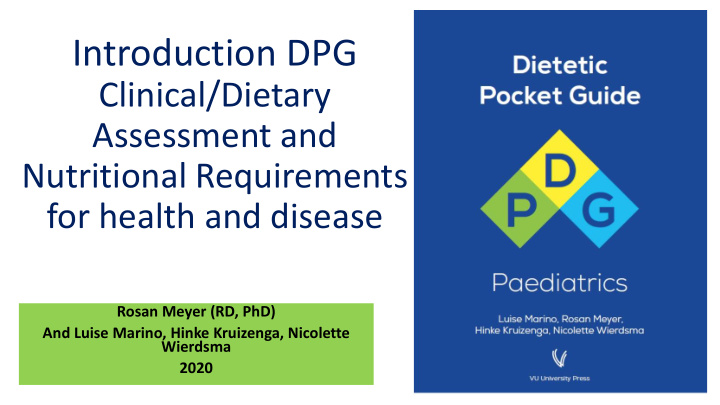



Introduction DPG Clinical/Dietary Assessment and Nutritional Requirements for health and disease Rosan Meyer (RD, PhD) And Luise Marino, Hinke Kruizenga, Nicolette Wierdsma 2020
Conflict of In Interest • Academic lectures for: • Danone/Nutricia • Mead Johnson • Nestle • Research grant holder: Danone/Nutricia • Board member: CoMISS Nestle
Who are we?
Who are we?
How does the Pocket Guide work? • Guides nutritional management using the following principles: A – Anthropometry : when and how to perform measurements and how to interpret these. Covers also advanced anthropometrical measurements including DEXA, BodPod. B – Biochemistry: nutritional blood markers with normative values C – Clinical assessment: how to assess a child clinically D – Dietary intake assessment: different techniques are covered D – Dietary requirements: Macro and micronutrients are covered in general and one chapter focuses on requirements for specific diseases E – Evaluation: GI digestion, absorption and losses are described including drug nutrient interactions. Nutritional outcome markers are also provided
Interpretation of Growth Parameters
Biochemical Assessment • Low albumin • Low phosphate • Low potassium • Normal magnesium • Protocol followed for tight glucose control • ? Risk of refeeding syndrome ■ Weight-for-height < 3 SD, MUAC < 11.5 cm (6-59 months) with/without any sign of bilateral oedema and/or visibly wasting. ■ Very low weight or increased rates of weight loss (recent loss of weight of 1 kg or more/wk for 2 consecutive weeks or loss of weight of 500-999 g/wk for 2 consecutive weeks. ■ Minimal or no feeding prior to admission, or before commencing re- feeding,defined as acute food refusal or estimated energy intake 400-600 kcal/d or severe restriction (less than 50 % of required intake).
Clinical Assessment – Essential part of Nutritional Assessment
Diet History also Important in Critically Ill Children
Differences in Requirements in Children Disease: Unwell child on ward and poor growth Health Activity Disease: PICU Thermic Effect of Food Activity Growth Thermic Effect of Food Activity Growth Growth d REE REE REE In acute disease conditions TEE is not increased because of the reduction in PAL – SACN 2011
Calculations • Website: http://www.dieteticpocketguide.com/
Interpretation of Growth Parameters
Assessing Feeding Difficulties
Pediatr Allergy Immunol. 2018;29:689 – 704.
Differences in Requirements in Children Disease: Unwell child + poor height growth Health Activity Disease: PICU Thermic Effect of Food Activity Growth Thermic Effect of Food Activity Growth Growth d REE REE REE In acute disease conditions TEE is not increased because of the reduction in PAL – SACN 2011
Requirements for Health and Disease • EAR/DRV developed for groups and not individuals • “It is important to note that DRVs should be used to assess the energy requirements for large groups of people and populations, but should not be applied to individuals due to the large variation in physical activity and energy expenditure observed between people. “ • EAR/DRV does not account for impact of disease: • “Standard reference tables or equations for estimating BMR (from weight, height and age) were established for use in healthy subjects without malnutrition and disease, and without dehydration and oedema, all of which can have substantial effects on body weight .” • EAR/DRV does not account weight loss • Important to use requirements that are evidence based SACN. Dietary Reference Values for Energy Scientific Opinion on Dietary Reference Values for energy. EFSA Journal 2011; ISBN: 9780108511370. 2013;11(1):3005. [112 pp.] doi:10.2903/j.efsa.2013.3005. Available online
Establishing Requirements
Requirements for Vitamins and Minerals for Catch-up Growth Type I Nutrients: Type II Nutrients: Growth nutrients Biochemical functions Deficiencies of these nutrients Deficiencies- less healthy and - Energy (fat/carbohydrates) Susceptible to stress and - AA Infections - Water -Vitamins and mineral - Sodium Trace Elements - Chloride Not malnourished with - Zinc Just type 1 nutrient Will lead to malnutrition: deficiency Wasting and stunting Golden MH. Food and Nutrition Bulletin, vol. 30, no. 3 2009
Conclusion • Nutritional assessment includes • Anthropometrics • Biochemistry • Clinical assessment • Dietary assessment • A complete nutritional assessment informs nutritional requirements • Important to understand differences in requirements between health and disease • Use evidence based requirements
Recommend
More recommend